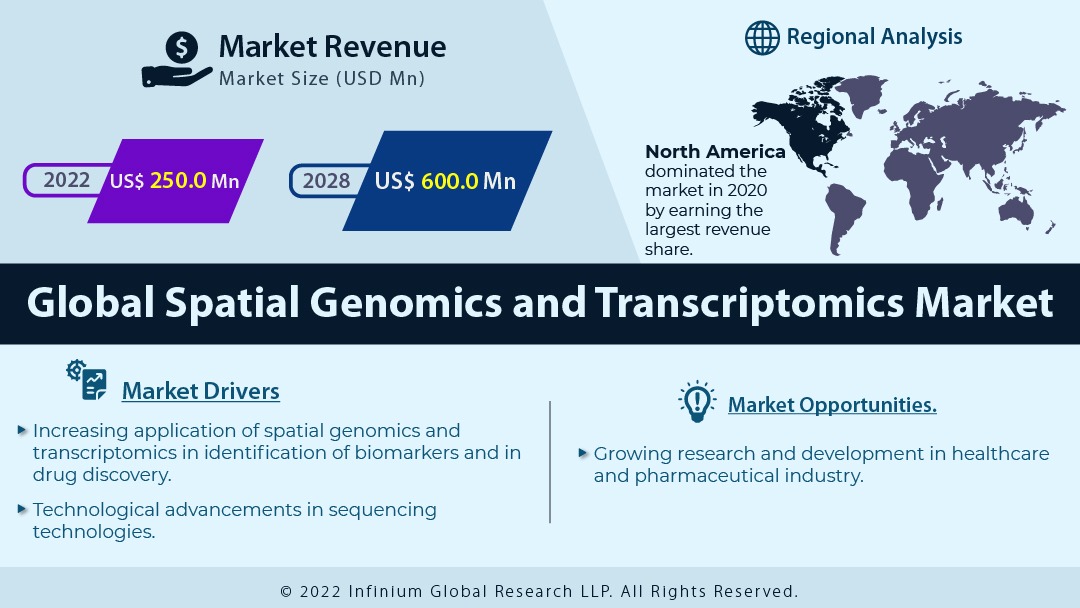Spatial Genomics and Transcriptomics Market (Technique - Spatial Transcriptomics, and Spatial Genomics; Product - Instruments, Consumables, and Software; Application - Drug Discovery, and Translational Research; End User - Academic & Research Institutes, CROs, Pharmaceutical, and Biotech Companies): Global Industry Analysis, Trends, Size, Share and Forecasts to 2028
A recent report published by
Infinium Global Research on the spatial genomics and transcriptomics market
provides in-depth analysis of segments and sub-segments in the global as well
as regional spatial genomics and transcriptomics market. The study also
highlights the impact of drivers, restraints, and macro indicators on the
global and regional spatial genomics and transcriptomics market over the short
term as well as long term. The report is a comprehensive presentation of
trends, forecast and dollar values of the global spatial genomics and
transcriptomics market. According to the report, the global spatial genomics
and transcriptomics market is projected to grow at a CAGR of nearly 17% over
the forecast period of 2022-2028.
Market Insight
The spatial genomics and transcriptomics market was valued at nearly USD 250 million in 2022 and is expected to reach about USD 600 million in 2028, with a CAGR of nearly 17% during the forecast period. A broad term used in the histological sections for various methods designed to assign cell types to their specific locations is known as spatial transcriptomics. Spatial transcriptomics can also be used to determine the subcellular localization of mRNA molecules. The researcher can discover and study cellular heterogeneity in tissues, immune cells, and tumors by determining the spatial distribution of mRNA molecules. Furthermore, spatial transcriptomics founds great use in oncology, immunology, histology, and embryology because it offers critical insights into the particular field. Moreover, spatial genomics mainly focuses on the assay of the genomic data of single cells within their native tissue environment. However, the biochemical techniques which have contributed significantly to the development of spatial genomics are advancements in in-situ fluorescence hybridization (FISH), microscopy-based live DNA imaging, parallel sequencing, and others. Additionally, with the use of spatial genomics and spatial transcriptomics, much research aims to bridge the gap of knowledge about cellular machinery, spatial organization, differentiation, and localization that exists at the genomic and transcriptomics level within each cell and in tissues.

The prime factors driving the
growth of the spatial genomics and transcriptomics market are the increasing
application of spatial and transcriptomics in identifying biomarkers and in
drug discovery, technological advancements in sequencing technologies, and
significant funding to expand research and development activities in
spatial-based technology. Additionally, the demand for high-resolution
multiplex assays and instruments rises due to the increasing prevalence of
chronic diseases and conditions such as genetic disorders, cancers,
neurological diseases, and rare diseases. This is projected to propel the
market’s growth during the forecast period. On the other hand, the factor which
can mainly hamper the market’s growth is the shortage of skilled professionals
and the lack of awareness about advanced technologies in developing countries.
However, the growing research and development in the healthcare and
pharmaceutical industry are expected to establish tremendous growth
opportunities for the key players in the spatial genomics and transcriptomics
market.
North America dominated the market
in 2020 by earning the largest revenue share. Further, the region is also
expected to register significantly steady revenue growth over the forecast
period. The fundamental reason for expanding the market in the area is
increasing investments to expand R&D activities in transcript and genomics.
Furthermore, increasing funding for disease pathology research, rising focus on
sequencing technologies, development of more advanced biomedical techniques,
and robust presence of key companies in the region are other considerable
factors expected to support market revenue growth over the forecast period. The
market revenue of Asia Pacific is also expected to expand rapid rate over the
forecast period. There is increasing collaboration by research and academic
institutions in countries in the region with internationally renowned
companies, which helps in the market's growth. Due to such partnerships, these
companies promote the adoption of new technologies in the area. Additionally,
the other factors expected to fuel market growth are improving healthcare
infrastructure and the availability of advanced research laboratories and
institutes in the region.
Segment Covered
The report on the global spatial
genomics and transcriptomics market covers segments such as technique, product,
application, and end user. On the basis of technique, the sub-markets include
spatial transcriptomics, and spatial genomics. On the basis of product, the
sub-markets include instruments, consumables, and software. On the basis of
application, the sub-markets include drug discovery, and translational
research. On the basis of end user, the sub-markets include academic &
research institutes, CROs, pharmaceutical, and biotech companies.
Companies Profiled:
The report provides profiles of
the companies in the market such as 10x Genomics, NanoString Technologies Inc,
Illumina Inc, Bio-Rad Laboratories, Natera Inc, S2 Genomics, Inc, Dovetail
Genomics, Bio-Techne, Seven Bridges Genomics, and Horizon Discovery Group plc.
Report Highlights:
The report provides deep insights
into demand forecasts, market trends, and micro and macro indicators. In
addition, this report provides insights into the factors that are driving and
restraining the growth in this market. Moreover, The IGR-Growth Matrix analysis
given in the report brings insight into the investment areas that existing
or new market players can consider. The report provides insights into the
market using analytical tools such as Porter's five forces analysis and DRO
analysis of the spatial genomics and transcriptomics market. Moreover, the study
highlights current market trends and provides forecast from 2022-2028. We also
have highlighted future trends in the market that will affect the demand during
the forecast period. Moreover, the competitive analysis given in each regional
market brings insight into the market share of the leading players.
